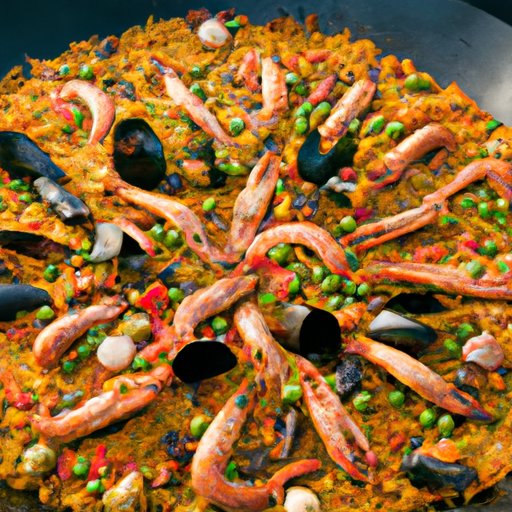Introduction
Paella is a traditional Spanish dish that has become a global favorite. It consists of rice cooked with various meats and vegetables, and flavored with spices like saffron. But where did this beloved dish originate? This article will explore the history and evolution of paella, from its humble beginnings in rural Spain to its current status as a worldwide phenomenon.

A Historical Overview of the Origins of Paella
The exact birthplace of paella is debated among food historians. Some believe that the dish originated in Valencia, while others claim that it was first created in Catalonia or Murcia. There are also several legends and myths surrounding the invention of paella.
Exploration of Legends and Myths
One popular legend tells of a Roman soldier named Paullus who had a taste for delicious dishes. He asked a local cook to prepare something special for him, and the result was the first paella. Another myth suggests that the dish was created by field workers who cooked their lunch over an open fire. The ingredients they used were whatever they could find in the fields, such as snails, beans, and rice.
Culinary Traditions in the Region
Historical records suggest that the earliest versions of paella may have been influenced by traditional Moorish and Arab cooking techniques. These cuisines had been introduced to the region centuries earlier, and their influence can still be seen today in the flavors and ingredients used to make paella. Additionally, the use of rice in Spanish cuisine dates back to the Middle Ages, when it was introduced by the Moors.

Examining the Ingredients and Techniques Used to Create Paella
In order to understand the origins of paella, it is important to look at the ingredients and techniques used to make it. Different regions of Spain have their own variations of the dish, but there are some common elements that are present in all recipes.
Types of Rice Used
The type of rice used to make paella is an important part of the dish. Short grain rice is typically used, as it absorbs more liquid and has a creamier texture than long grain rice. Bomba rice is the most popular variety used in paella, as it is able to absorb three times its weight in liquid without becoming mushy.
The Role of Saffron
Saffron is a key ingredient in paella, as it gives the dish its distinct flavor and yellow color. The spice is derived from the dried stigmas of the crocus flower, and has been used in Spanish cooking for centuries. Saffron adds complexity to the flavor of paella, and is essential for achieving the traditional taste.
Other Important Ingredients
Paella is usually made with a combination of seafood, meat, and vegetables. Common ingredients include shrimp, mussels, chicken, chorizo, onions, garlic, tomatoes, peas, and peppers. The amount and type of ingredients used vary depending on the region and personal preference.
Technique for Cooking Paella
The technique for cooking paella is just as important as the ingredients used. The dish is cooked in a shallow pan over an open flame, which helps to give it its signature smoky flavor. The heat should be kept low and even, and the ingredients must be added in the right order to ensure that everything cooks evenly.

The Impact of Paella on Spanish Cuisine
Paella is one of the most iconic dishes in Spanish cuisine, and has had a significant impact on the country’s culinary culture. Here, we examine the popularity of paella in Spain and how it has evolved over time.
Popularity of Paella in Spain
Paella is a beloved dish in Spain, and can be found in restaurants and homes throughout the country. According to a study by the Spanish Ministry of Agriculture, Fisheries and Food, paella is the most popular dish in the country.
“Paella is a symbol of Spanish cuisine and culture,” said Juan Carlos Pérez, a professor at the University of Valencia. “It is a dish that brings people together, and has been enjoyed by generations of Spaniards.”
How Paella Has Evolved Over Time
Over the years, paella has evolved to incorporate new ingredients and cooking techniques. While the traditional recipe remains popular, modern versions of the dish often include different meats, vegetables, and spices. Additionally, chefs have experimented with different types of rice, such as wild rice and black rice, to give the dish a unique flavor.
How Paella Became a Global Sensation
Paella has become a global sensation in recent years, with chefs around the world adapting the dish to suit local palates. Here, we explore how paella has become a worldwide favorite.
Adaptations to Local Palates
Chefs have adapted paella to suit the tastes of different cultures. In the United States, for example, chefs have added American ingredients like bacon and corn to give the dish an extra kick. Other countries have experimented with different types of seafood, such as squid and clams, to create unique flavors.
Prominent Celebrity Chefs Who Have Popularized Paella
Celebrity chefs have played an important role in popularizing paella around the world. Chefs like José Andrés and Jamie Oliver have shared their recipes for the dish, and have helped to introduce it to a wider audience.
Conclusion
This article has explored the origins and evolution of paella, from its humble beginnings in rural Spain to its current status as a global favorite. We examined the ingredients and techniques used to make the dish, its impact on Spanish cuisine, and how it became a worldwide sensation. Paella is an example of the power of food to bring people together and bridge cultural divides.
(Note: Is this article not meeting your expectations? Do you have knowledge or insights to share? Unlock new opportunities and expand your reach by joining our authors team. Click Registration to join us and share your expertise with our readers.)
